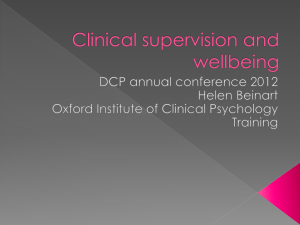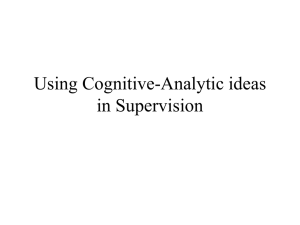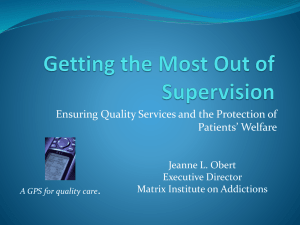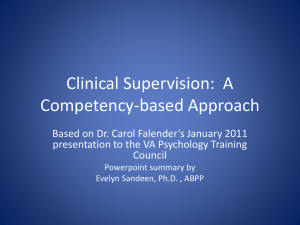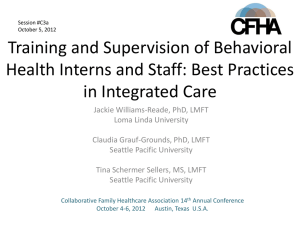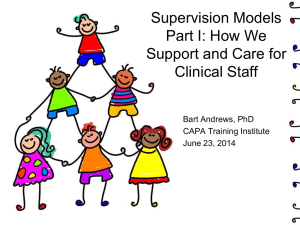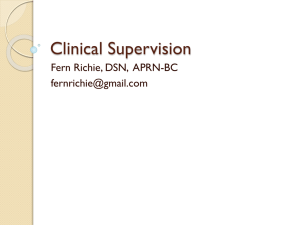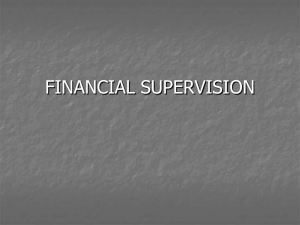2011 Supervision Workshop
advertisement
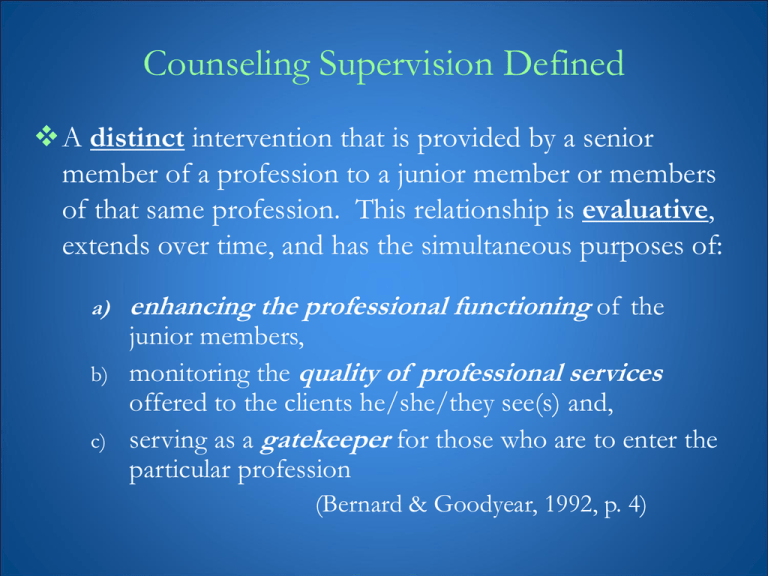
Counseling Supervision Defined A distinct intervention that is provided by a senior member of a profession to a junior member or members of that same profession. This relationship is evaluative, extends over time, and has the simultaneous purposes of: a) b) c) enhancing the professional functioning of the junior members, monitoring the quality of professional services offered to the clients he/she/they see(s) and, serving as a gatekeeper for those who are to enter the particular profession (Bernard & Goodyear, 1992, p. 4) Supervision Theory Supervision is more than meeting once a week to discuss whether or not your supervisee is doing it right. Supervision is a process that looks different from supervisee to supervisee. Supervision is a process that looks different throughout the supervisee’s professional development Clinical supervision is recognized as a complex exchange between supervisor and supervisee, with supervisory models/theories developed to provide a frame for it. Determinants of Supervisor Behavior Development and Validation of the Supervisory Styles Inventory, (Friedlander and Ward, 1984) Assumptive World Theoretical Orientation Style-Role Strategy-Focus Format Technique Models of Supervision Models Grounded in Psychotherapy Theory Psychodynamic Person-Centered Cognitive Behavioral Constructivist Developmental Models Social Role Models Integrated Development Model (IDM) The Loganbill, Hardy, and Delworth Model The Ronnestad and Skovholt Model The Discrimination Model (Bernard) The Hawkins and Shohet Model The Holloway Systems Model Models Grounded in Psychotherapy Theory Person-Centered Rogers was the first to report using taped sessions for supervision Counseling theory informed his supervision process Belief in growth potential Emphasis on facilitative conditions “No clean way” to differentiate supervision from therapy Profound trust that the supervisee has within him/herself the ability and motivation to grow and explore both the therapy situation and the self Person-centered supervision relies heavily on the supervisorsupervisee relationship to facilitate effective learning and growth in supervision. Models Grounded in Psychotherapy Theory Cognitive Behavioral 1. Proficient counselor performance is more a function of learned skills than a “personality fit”. 2. The counselor’s professional role consists of identifiable tasks, each one requiring specific skills. 3. Counseling skills are behaviorally definable and are responsive to learning theory, just as are other behaviors. 4. Supervision should employ the principles of learning theory within its procedures. Models Grounded in Psychotherapy Theory Constructivist (Solution-Focused) Solution focused supervision validates the competence and resources of the supervisee, emphasizes the importance of clear incremental goals and identifies pre-existing solutions and exceptions to problems in the supervisee’s work … it focuses more on what the supervisee is doing, rather than on client issues directly. (O’Connell & Jones, 1997) Models Grounded in Psychotherapy Theory Constructivist (Solution-Focused) Primary Principle: To coax and author expertise from the life, experience, education and training of a supervisee, rather than to deliver or teach expertise from a hierarchically superior position. (White & Epston, 1990) Models Grounded in Psychotherapy Theory Constructivist (Solution-Focused) General Principles: 1. Rather than being didactic, help the supervisee to draw on his or her own resources, and learn to behave independently 2. Establish a collaborative relationship 3. Focus on supervisee’s strengths and successes rather than failures 4. Take advantage of the snowball effect and work toward small changes, rather than only the large ones 5. Work to achieve what is possible 6. Accept that there is no one correct way Models Grounded in Psychotherapy Theory Constructivist (Solution-Focused) Solution-Focused Supervision is Collaborative Curious Respectful Based on the same premises as SFBT Client/Supervisee defines goals Rapid change is possible Different views are each as valid Focus on what is possible and changeable Models Grounded in Psychotherapy Theory Constructivist (Solution-Focused) The Use of Exceptions Identify and amplify the supervisee’s exceptional behavior, punctuating them using compliments Help supervisees focus on those times when things went well – or at least not as badly Prevent supervisees from awfulizing Identify areas of competence Models Grounded in Psychotherapy Theory Constructivist (Solution-Focused) Ideas and techniques within solution-based therapies that are applicable in the supervisory relationship The use of scales Focused questions Looking for exceptions Constructive feedback Follow-up tasks Adopt the stance of a curious inquirer Models Grounded in Psychotherapy Theory Constructivist (Solution-Focused) Dialogue Questions in Solution-Focused Supervision What aspect of your counseling have you noticed getting better since we last met? Tell me about the best thing you did with your client this week. As you begin to get better at dealing with this situation, how will you know that you have become good enough at it so you can take it on your own? What will you be doing differently? When you get to the point at which you won’t need to deal with this issue in supervision anymore, how will you know? Models Grounded in Psychotherapy Theory Constructivist (Solution-Focused) Dialogue Questions in Solution-Focused Supervision On a scale of 1 to 10, with 1 being that the problem is at its absolute worst, and 10 being that the problem is completely solved, where would you say you are today? When you are on your way to a (the next highest number to the one named), how will you know? What, in particular, will be different about the way you handle that situation? How will you have changed as a counselor? The Miracle Question Developmental Models Primary focus is on how supervisees change as they gain training and supervised experience Two primary assumptions: 1. In the process of moving toward competence, supervisees move through a series of stages that are qualitatively different from one another. 2. Each stage requires a qualitatively different supervisory environment if optimal supervisee satisfaction and growth are to occur. Developmental Models The Ronnestad and Skovholt Model Articulates the ways that counselors continue to develop across the life-span Phase 1: The Lay Helper Phase Phase 2: The Beginning Student Phase Phase 3: The Advanced Student Phase Phase 4: The Novice Professional Phase Phase 5: The Experienced Professional Phase Phase 6: The Senior Professional Phase Developmental Models The Loganbill, Hardy, and Delworth Model Issues in Supervision Integration Stagnation Confusion 1. 2. 3. 4. 5. 6. 7. 8. 9. 10. Supervisory Relationship Competence Emotional Awareness Purpose and Direction Autonomy Personal (e.g., Blind Spots) Respect for Individual Differences Professional Ethics Motivation Identity Developmental Models Integrated Developmental Model (IDM) Counselor development occurs across four stages with three overriding structures Self-Other Awareness Motivation Autonomy Level 1: Supervisees have limited training Level 2: Supervisees are transitioning away from high dependence Level 3: Supervisees are focusing more on a personalized approach Level 3i: Supervisees are integrating across all three domains Integrated Developmental Model (IDM) Best known and most widely used model Both descriptive of trainee process and prescriptive with respect to supervisor interventions Describes counselor development as occurring through three stages in three overriding structures Self-Other Awareness: Where the supervisee is in terms of self-preoccupation, awareness of the client’s world, and enlightened self-awareness Motivation: Reflects the supervisee’s interest, investment, and effort expended in clinical training and practice Autonomy: Reflects the degree of independence that the supervisee is manifesting Integrated Developmental Model (IDM) Level 1: These supervisees have limited training, or at least limited experience in the specific domain in which they are being supervised Awareness: High self focus, with limited self-awareness; apprehensive about evaluation. Motivation: Both motivation and anxiety are high; focused on acquiring skills. Want to know the “correct” or “best” approach with clients. Autonomy: Dependent on supervisor. Wants to leave major decision making to supervisor. Needs structure, positive feedback, and little direct confrontation. Integrated Developmental Model (IDM) Level 2: Supervisees at this level are making the transition from being highly dependent, imitative, and unaware in responding to a highly structured, supportive, and largely instructional supervisory environment Awareness: Greater ability to focus on and empathize with client. However, balance is still an issue. Problem can be veering into enmeshment with the client. Motivation: Supervisee vacillates between being very confident to self-doubting and confused Autonomy: Although functioning more independently, supervisee experiences conflict between autonomy and dependency. Can manifest as resistance to the supervisor. Integrated Developmental Model (IDM) Level 3: Supervisees at this level are focusing more on a personalized approach to practice and on using and understanding of “self” in therapy. Awareness: Supervisees are now able to remain focused on the client while also stepping back to attend to their own personal reactions to the client. Motivation: Supervisee begins to integrate own style of therapy and work on strengths and weaknesses. Seesawing slows, and he or she feels more consistent about skills. Id freely able to receive feedback from supervisor. Autonomy: Feels comfortable functioning more independently. When doubts arise, supervisee feels he or she can consult with others without losing his or her sense of professional identity. Integrated Developmental Model (IDM) Level of Development and Supervisee Characteristics (Awareness, Motivation, Dependency) High Medium Low Level 1 Level 2 Level 3 Social Role Models Supervisory Roles Teacher Monitor evaluator Counselor Coach Colleague Boss Expert technician Manager of administrative relationships Hawkins and Shohet, 2006 Three Widely Accepted Roles Teacher Counselor Consultant Supervision is a separate skill similar to teaching – but different; similar to counseling – but different; and similar to consulting – but different. (Douce, 1989) Social Role Models The Hawkins and Shohet Model The role of the supervisor is driven by the mode of focus: Mode 1: Content of the Supervision Session Mode 2: Strategies and Interventions Mode 3: Therapy Relationship Mode 4: Counselor’s Process Mode 5: Supervisory Relationship Mode 6: Supervisor’s Own Process Mode 7: Wider Context Social Role Models The Holloway Systems Model Perhaps the most comprehensive model of supervision Emphasis on Tasks and Functions of supervision Tasks: Monitoring – Evaluating Instructing – Advising Modeling Consulting Supporting – Sharing Functions: Counseling Skill Case Conceptualization Professional Role Emotional Awareness Self-Evaluation Social Role Models The Discrimination Model Attends to three separate areas of focus as well as three supervisor roles Foci 1. Intervention Skills 2. Conceptualization Skills 3. Personalization Skills Supervisor Roles 1. Teacher 2. Counselor 3. Consultant Bernard’s Discrimination Model Another “best” known model of supervision with strong empirical support (Ellis & Dell, 1986). Forms a matrix or grid of supervisor roles – teacher, counselor, and consultant with supervisor’s focus for each role. Discrimination Model Matrix (With Examples) Supervision Focus Area Supervisor Roles Counseling Teacher Counselor Performance Help supervisee Work on skills Skills to practice needed to various respond to client What a interventions challenges, supervisee does and techniques. delivered in an during a empathic manner. counseling session Consultant Help supervisee to generate ideas about other interventions that might work with a client. Discrimination Model Matrix (With Examples) Supervision Focus Area Cognitive Counseling Skills How a supervisee thinks before, during, and after a session Supervisor Roles Teacher Counselor How does a Reframe client’s family history challenging of substance behaviors as selfabuse influence protection. client’s current behavior? Consultant Work on understanding why a particular intervention didn’t work with a family. Discrimination Model Matrix (With Examples) Supervision Focus Area Self Awareness Supervisee’s recognition of personal issues, beliefs, and motivations Supervisor Roles Teacher Explain how supervisee’s reactions to client are informative about the client’s self presentation. Counselor Consultant Help supervisee Respond to identify feelings supervisee’s of defensiveness request to in response to a explore client’s negative challenging feelings about a behavior. client. Discrimination Model Matrix (With Examples) Supervision Focus Area Supervisor Roles Professional Teacher Counselor Consultant Behaviors Explain how an Explore In an ethical ethical standard supervisee’s situation, help Adherence to applies to a conflicting generate ethical, legal, client situation. feelings about options for and needing to break responding to a professional confidentiality. client. guidelines Supervisor Inquiry Questions 1. 2. 3. 4. 5. What do you wish you had said to him or her? How do you think he or she would have reacted if you had said that? What would have been the risk in saying what you wanted to say? If you had the chance now, how might you tell him or her what you are thinking and feeling? Were there any other thoughts going through your mind? Supervisor Inquiry Questions 6. 7. How did you want the other person to perceive you? Were you aware of any feelings? Does that feeling have any special meaning for you? 8. What did you want him or her to tell you? 9. What did you think he or she wanted from you? 10. Did he or she remind you of anyone in your life? Limitations of Supervision Models Too simplistic Too prescriptive Do not provide ‘the answers’! All supervisees are different Research seems to be suggesting two themes In a crisis we all need structure The most important factor in effective supervision is the relationship (Norcross, 2002) Clinical Supervision “The competent clinical supervisor must embrace not only the domain of psychological science but also the domains of client service and supervisee development. The competent supervisor must not only comprehend how these various knowledge bases are connected, but also apply them to the individual case” (Holloway & Wolleat, 1994, p. 30). Clinical Supervision Two Major Themes in all Supervision Models 1. Relationship o Your relationship with the supervisee is central to effective supervision 2. Process/Development o Different modes/styles/levels/etc. of supervision are necessary throughout the supervisory relationship
